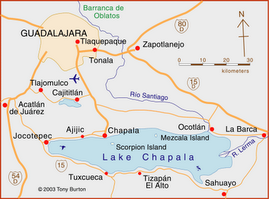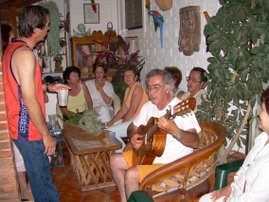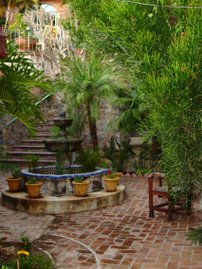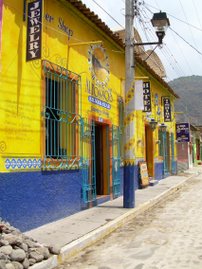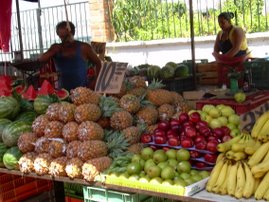Some final thoughts on our Mexico City trip…
I must say, I had some reluctance to plan this trip. Although we knew there were some beautiful and important things to see in Mexico City, I was prepared to “endure” the huge megalopolis, its pollution, the unsafe traffic, and the security concerns. We knew we wanted to see Mexico City, but we did not anticipate such a pleasant experience.
Visiting the city was very much like visiting any world class city. We’ve been to London, Paris, Rome, New York, Chicago, and Mexico City was, frankly, very similar in many ways. There were marvelous museums, restaurants of all ethnic cuisine and price ranges, and generally a vibrant and interesting citizenry. We encountered many young, professional, beautiful Mexican people. The DF, (District Federal) as the Mexicans call it, is exceptionally politically liberal, and we saw evidence of labor demonstrations, gay rights, and abortion rights. The pollution was not noticeable, and seemed much less than what we’ve seen in Guadalajara. We felt completely safe walking the streets in the centro historico area, as well as in all the other districts we visited. Only one night, when we walked several blocks and got lost looking for a restaurant, and we passed a community of homeless people sleeping in the street were we a bit uncomfortable, but they were fine and did nothing to make us feel unsafe. We would not hesitate to visit the city again by ourselves.
Now, back in Ajijic, we are enjoying the climate as the rainy season is ending, slowly. The mountains are still a brilliant green, the air is clear, and the evening temperatures cool. Our Great Books conversation series started last week with a discussion of Iris Murdoch’s novel, The Bell. Pixie is back teaching English at the orphanage. My student, Francisco, is enrolled in Level 2 English, and I am still working with him on Saturdays.
We had a wonderful surprise a week or so ago when we reconnected with our first friends we met in Mexico, Ron and Jan. Ron was an Air Canada pilot, and Jan a nurse. We originally met in the B&B when we were visiting Mexico in June 2006. We had lost touch with them, but they contacted us and asked us to dinner. They live out in the country, East of Chapala, in a small town, San Nicholas, along with just a handful of other gringos. Like me, Ron took a fall and had a serious head injury, but he is recovering well. We are looking forward to seeing them more regularly. Here are some photos of them on their new property where they are building a home and at their rental house with their six (yes, six!) dogs at feeding time:
It was our turn to host the Maine-New Hampshire-Massachusetts get together this month. We met down by our pool area for drinks and appetizers then went to a local Mexican eatery. We happened to meet a new couple who had just arrived, that day, from Hawaii to live here permanently. So we invited them along even though they hardly met the “New England” membership requirement. Here are some photos:
Yesterday, Pixie and her good friend, Jan Steinbright, conducted the service at our Unitarian Fellowship. It included rituals to celebrate the fall equinox. they did a wonderful job making everyone feel comfortable and included. It was a great success. Here are photos:
We had our annual awards banquet hosted by the publisher of our English-language magazine El Ojo del Lago. I was fortunate to win the award again or best poem of the year. It is a poem about the history of Mexico using the metaphor of a Mexican woman to represent the country itself. It is called “Mother Mexico” and is included here:
MOTHER MEXICO
She is a beautiful dama.
Her dark tragic eyes call to us.
Her dark smooth hair flows
over her face, down her back,
reminding me of every mother’s love.
Her red lips sing
the songs of the Indio,
songs of hope, songs of loss.
She lulls me with her stunning beauty,
but her allure hides the pain,
hides the tears
hides the bood,
all spilled
over the murder
over the pride
over the cruelty,
over her lost sons.
For she was young
and full of hope
and her beauty was plundered
and her chastity stolen
by craven men
who could never embrace
her native radiance.
She was enslaved and used
in the name of fealty and faith,
but she was left naked
to bake in the sun.
But she was strong.
She survived to love again.
Wrapped in her new colors,
she danced and she sang
late into the night.
Her sons swore their solemn oath
to stand with her always.
Yet, her sons were proud
and they fought to protect her
and they bled in her name
and they held her up
as innocent as Guadalupe,
but they slay one another
in her name.
And more tears and more blood
flowed into the dust,
down from the mountains
and into the hearts
of all her children.
And now, as the music of the Mariachi
echoes in her ears,
and the smell of the pork in chili
saturates the air,
the bitter taste of love lost
and promises unkept
quickens her tongue.
The tears and blood
which blur her vision
drip slowly onto her brown feet,
as she walks slowly
through her fragrant garden
under the mango tree
into her small cocina
to roll the masa,
to burn her fingertips
on the hot griddle
as she makes the tortillas
to sustain her grandchildren,
who watch her with love
and with fresh eyes, unclouded
by betrayal,
by the sins of man.
And she serves comida
in the cool shadows
as she looks over the garden wall
at the blood red sun.


























